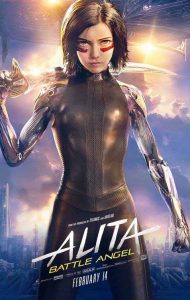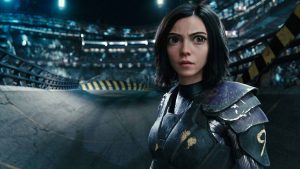Director Robert Rodriguez immerses us in a new futuristic world with his newest movie, “Alita: Battle Angel.”
Set in the year 2563, this sci-fi, action-filled movie follows a powerful cyborg heroine, Alita (Rosa Salazar), after she is reactivated by her rescuer, Dr. Dyson Ido (Christoph Waltz). The movie shows how Alita figures out who she was before she became deactivated, and throughout the movie, we get to watch as she develops into the warrior she used to be.

Photo courtesy IMDb
Much of the visual inspiration for “Alita” came from the manga series “Gunnm,” on which the story is based, and the details of the graphic novels were transferred to screen effectively. However, Rodriguez and co-writer and producer James Cameron create a fascinating film that almost seems like a combination of their most popular movies, “Spy Kids” and “Avatar.”
The action scenes are similar to the ones seen in Rodriguez’s “Spy Kids” series but amped up in technology, speed and violence, and the dystopian environment around the characters could only come from Cameron — the same mind that created Pandora in “Avatar.”
The world we are thrown into has huge potential to create a powerful story with its stunning futuristic visuals and advanced technology. It takes place on Earth 300 years after an event called “The Fall,” and as more context is given about the Earth’s history, the audience steadily grows more interested in what happened during “The Fall” than they are in the plot of “Alita.”
One of the best visual effects used in the film is the way Alita’s character was created. Salazar wore motion-capturing sensors while acting, so a complete CGI character appears on screen with accentuated eyes and a mechanical body that resemble the image in the manga.
Salazar does an awesome job with her performance as Alita. There is a huge character arc that has to be developed in two hours, and she is able to portray that development convincingly.
Without a doubt, she outshines the star-studded cast (Waltz, Mahershala Ali and Jennifer Connelly), but the visual effects crew outperforms them all. Without its surprisingly gory action sequences and uniquely designed characters, “Alita” would have little success in drawing attention away from its flaws.

Photo courtesy IMDb
Writers Laeta Kalogridis and Cameron underwhelm with much of their dialogue, primarily during some of the action and romance scenes. The phrases thrown out are often cheesy and overdramatized, but Cameron and Kalogridis are able to compensate for those throwaway lines by seamlessly getting each character to share the context of the story.
In Oxford theaters now, “Alita: Battle Angel” represents much of what cinematic storytelling is visually about, and even though there are imperfections, the visual effects alone outweigh those faults and make “Alita” an entertaining watch. It is a must-see for those who enjoy a good sci-fi film with lots of violent action scenes, and it’s not bad in 3D.






